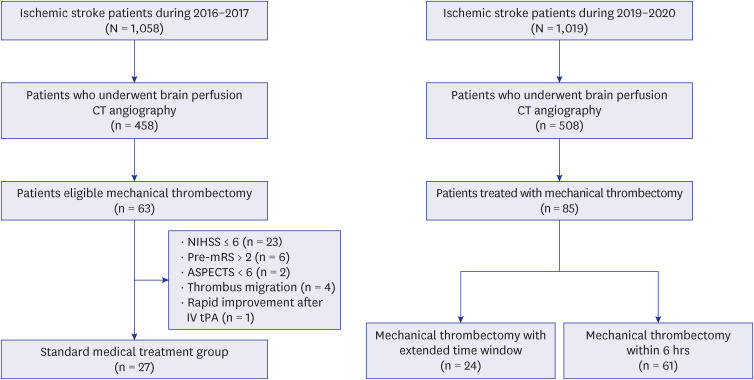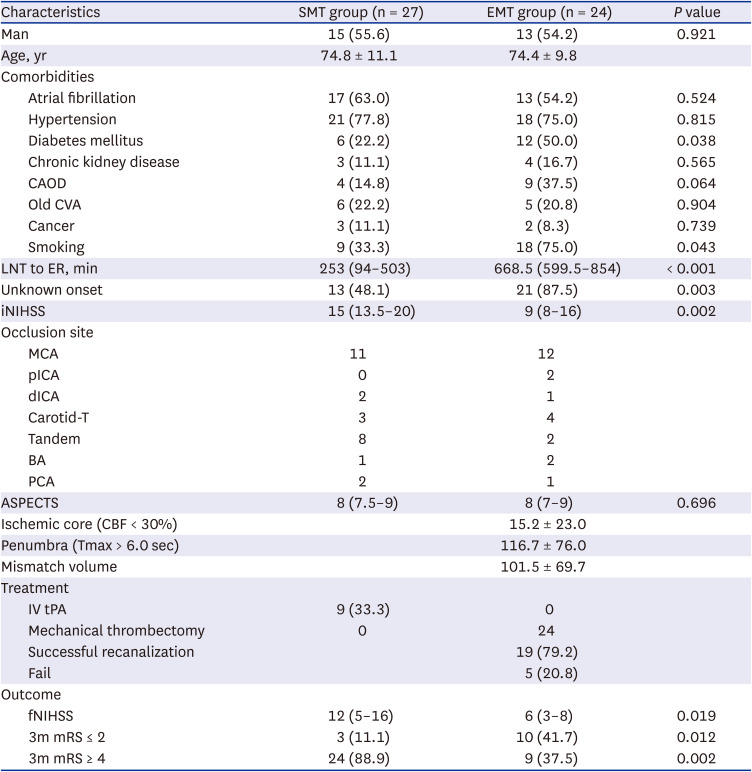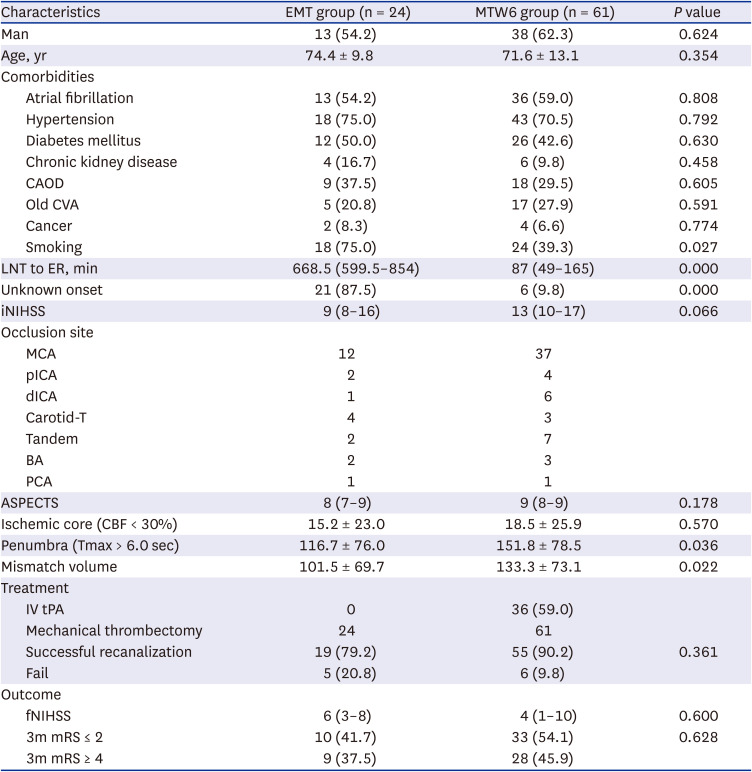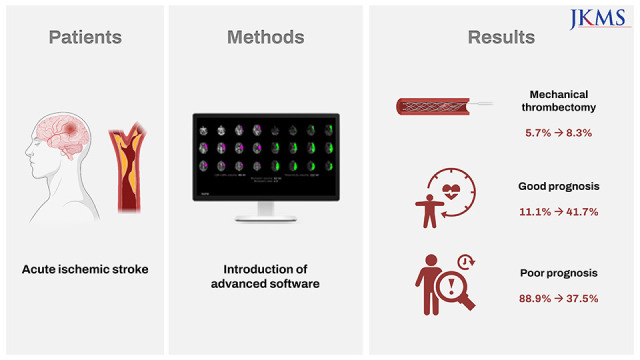1. Ko SB, Park HK, Kim BM, Heo JH, Rha JH, Kwon SU, et al. 2019 update of the Korean clinical practice guidelines of stroke for endovascular recanalization therapy in patients with acute ischemic stroke. J Stroke. 2019; 21(2):231–240. PMID:
30991800.
2. National Institute of Neurological Disorders and Stroke rt-PA Stroke Study Group. Tissue plasminogen activator for acute ischemic stroke. N Engl J Med. 1995; 333(24):1581–1587. PMID:
7477192.
3. Powers WJ, Derdeyn CP, Biller J, Coffey CS, Hoh BL, Jauch EC, et al. 2015 American Heart Association/American Stroke Association focused update of the 2013 guidelines for the early management of patients with acute ischemic stroke regarding endovascular treatment: a guideline for healthcare professionals from the American Heart Association/American Stroke Association. Stroke. 2015; 46(10):3020–3035. PMID:
26123479.
4. Jeong HS. An update of recent guideline for the endovascular recanalization therapy in acute ischemic stroke. J Korean Neurol Assoc. 2018; 36(3):145–151.
5. Albers GW, Marks MP, Kemp S, Christensen S, Tsai JP, Ortega-Gutierrez S, et al. Thrombectomy for stroke at 6 to 16 hours with selection by perfusion imaging. N Engl J Med. 2018; 378(8):708–718. PMID:
29364767.
6. Nogueira RG, Jadhav AP, Haussen DC, Bonafe A, Budzik RF, Bhuva P, et al. Thrombectomy 6 to 24 hours after stroke with a mismatch between deficit and infarct. N Engl J Med. 2018; 378(1):11–21. PMID:
29129157.
7. Powers WJ, Rabinstein AA, Ackerson T, Adeoye OM, Bambakidis NC, Becker K, et al. 2018 Guidelines for the early management of patients with acute ischemic stroke: a guideline for healthcare professionals from the American Heart Association/American Stroke Association. Stroke. 2018; 49(3):e46–110. PMID:
29367334.
8. Seo KD, Suh SH. Endovascular treatment in acute ischemic stroke: a nationwide survey in Korea. Neurointervention. 2018; 13(2):84–89. PMID:
30196678.
9. Powers WJ, Rabinstein AA, Ackerson T, Adeoye OM, Bambakidis NC, Becker K, et al. Guidelines for the early management of patients with acute ischemic stroke: 2019 update to the 2018 guidelines for the early management of acute ischemic stroke: a guideline for healthcare professionals from the American Heart Association/American Stroke Association. Stroke. 2019; 50(12):e344–e418. PMID:
31662037.
10. Rangaraju S, Haussen D, Nogueira RG, Nahab F, Frankel M. Comparison of 3-month stroke disability and quality of life across modified rankin scale categories. Interv Neurol. 2017; 6(1-2):36–41. PMID:
28611832.
11. Beckhauser MT, Castro-Afonso LH, Dias FA, Nakiri GS, Monsignore LM, Martins Filho RK, et al. Extended time window mechanical thrombectomy for acute stroke in Brazil. J Stroke Cerebrovasc Dis. 2020; 29(10):105134. PMID:
32912530.
12. Virtanen P, Tomppo L, Martinez-Majander N, Kokkonen T, Sillanpää M, Lappalainen K, et al. Thrombectomy in acute ischemic stroke in the extended time window: real-life experience in a high-volume center. J Stroke Cerebrovasc Dis. 2022; 31(8):106603. PMID:
35749938.
13. Hui W, Wu C, Zhao W, Sun H, Hao J, Liang H, et al. Efficacy and safety of recanalization therapy for acute ischemic stroke with large vessel occlusion: a systematic review. Stroke. 2020; 51(7):2026–2035. PMID:
32486966.
14. Gunda B, Sipos I, Stang R, Böjti P, Dobronyi L, Takács T, et al. Comparing extended versus standard time window for thrombectomy: caseload, patient characteristics, treatment rates and outcomes-a prospective single-centre study. Neuroradiology. 2021; 63(4):603–607. PMID:
32935174.
15. Kim JY, Kang K, Kang J, Koo J, Kim DH, Kim BJ, et al. Executive summary of stroke statistics in Korea 2018: a report from the Epidemiology Research Council of the Korean Stroke Society. J Stroke. 2019; 21(1):42–59. PMID:
30558400.
16. MacKenzie IE, Moeini-Naghani I, Sigounas D. Trends in endovascular mechanical thrombectomy in treatment of acute ischemic stroke in the United States. World Neurosurg. 2020; 138:e839–e846. PMID:
32229302.
17. Rinaldo L, Rabinstein AA, Cloft H, Knudsen JM, Castilla LR, Brinjikji W. Racial and ethnic disparities in the utilization of thrombectomy for acute stroke. Stroke. 2019; 50(9):2428–2432. PMID:
31366313.
18. Richter D, Weber R, Eyding J, Bartig D, Misselwitz B, Grau A, et al. Acute ischemic stroke care in Germany - further progress from 2016 to 2019. Neurol Res Pract. 2021; 3(1):14. PMID:
33789773.
19. Chia NH, Leyden JM, Newbury J, Jannes J, Kleinig TJ. Determining the number of ischemic strokes potentially eligible for endovascular thrombectomy: a population-based study. Stroke. 2016; 47(5):1377–1380. PMID:
26987869.
20. Jadhav AP, Desai SM, Kenmuir CL, Rocha M, Starr MT, Molyneaux BJ, et al. Eligibility for endovascular trial enrollment in the 6- to 24-hour time window: analysis of a single comprehensive stroke center. Stroke. 2018; 49(4):1015–1017. PMID:
29581344.
22. Aroor SR, Asif KS, Potter-Vig J, Sharma A, Menon BK, Inoa V, et al. Mechanical thrombectomy access for all? Challenges in increasing endovascular treatment for acute ischemic stroke in the United States. J Stroke. 2022; 24(1):41–48. PMID:
35135058.
23. Hassan AE. New Technology Add-On Payment (NTAP) for Viz LVO: a win for stroke care. J Neurointerv Surg. 2021; 13(5):406–408. PMID:
33234600.
24. Kim B, You SH, Jung SC. A multicenter survey of acute stroke imaging protocols for endovascular thrombectomy. Neurointervention. 2021; 16(1):20–28. PMID:
33267533.







 PDF
PDF Citation
Citation Print
Print





 XML Download
XML Download